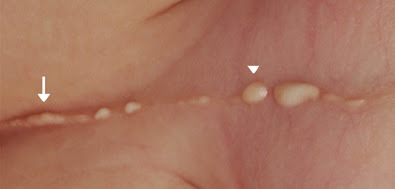Perineal Raphe in Female and Male, Irritation, Bump, Cyst
Perineal raphe is a tissue line or ridge which originates from anus through the perineum. It is basically the fusion point of urogenital folds and present in both males and females. This tissue line continues through the center portion of scrotum and runs upward through the posterior side of penis right from midline aspect. Perineal raphe develops during fetal development inside mother’s womb. Starting stages of fetal development looks same but at 7th week of pregnancy, fetal genital tissues change and form male reproductive organs i.e. penis and scrotum. At this point, perineal raphe is formed.It is completely common and normal physiological tissue line.
Perineal raphe is present in both males and females. In females, perineal raphe originates from anus and continues running upward to female genitalia i.e. passing through vagina till clitoris. In males, perineal raphe originates from anus and extends in upward direction to scrotum and then through posterior side of penis. Perineal raphe on scrotum, also divides it into two portions from inside which is known as scrotum raphe and when this line of tissues runs through midline aspect of penis posteriorly, it is known as penile raphe.

Perineal raphe itching is most common in men than women and the reason behind this difference is unknown. Person feels itching and discomfort. It occurs occasionally due to sweating and cause burning and soreness along with irritation. This irritation and burning may extend up to anus and is called as pruritus ani. Person overwhelmed to scratch raphe and over scratching may lead to injury due to removal of upper protective layers of skin. Moisture, clothing, sweating and pressure upon sitting are other causative factors. Usually perineal raphe itching increases at night time and after every bowel movement.
Perineal raphe bump is a lump formation on the line of tissues i.e. perineal raphe. These bumps can occur anywhere on perineal raphe most commonly around anus. These bumps are present inside skin and are not visible on surface. Person can feel it on touching and it hurts on wiping the area, sitting or moving around. These bumps may be 1 or 2 to 3 in number. Sometimes these bumps are painful. Pain is not unbearable, it’s tolerable. Sometimes it is itchy if it occurs due to an infection. Perineal raphe bumps most commonly occur in females.
Cyst may form anywhere on perineal raphe and genital organs i.e. penis and scrotum in males. Main structures involved are glans penis, penile shaft, scrotum or perineum. These cyst are common benign lesions. These lesions most commonly form in adolescence and childhood. In childhood, these cyst are asymptomatic and are unrecognized. These cyst only show symptoms when these get worse due to trauma and infection. Perineal cyst have an epithelial lining which may be urethral type, epidermoid type, mixed type and glandular type epithelium. The most rarely found cyst are median raphe cyst with ciliated epithelium.
Perineal raphe in Male and Female
Perineal raphe is present in both males and females. In females, perineal raphe originates from anus and continues running upward to female genitalia i.e. passing through vagina till clitoris. In males, perineal raphe originates from anus and extends in upward direction to scrotum and then through posterior side of penis. Perineal raphe on scrotum, also divides it into two portions from inside which is known as scrotum raphe and when this line of tissues runs through midline aspect of penis posteriorly, it is known as penile raphe.

Perineal raphe Irritation
Perineal raphe itching is most common in men than women and the reason behind this difference is unknown. Person feels itching and discomfort. It occurs occasionally due to sweating and cause burning and soreness along with irritation. This irritation and burning may extend up to anus and is called as pruritus ani. Person overwhelmed to scratch raphe and over scratching may lead to injury due to removal of upper protective layers of skin. Moisture, clothing, sweating and pressure upon sitting are other causative factors. Usually perineal raphe itching increases at night time and after every bowel movement.
Perineal raphe Bump
Perineal raphe bump is a lump formation on the line of tissues i.e. perineal raphe. These bumps can occur anywhere on perineal raphe most commonly around anus. These bumps are present inside skin and are not visible on surface. Person can feel it on touching and it hurts on wiping the area, sitting or moving around. These bumps may be 1 or 2 to 3 in number. Sometimes these bumps are painful. Pain is not unbearable, it’s tolerable. Sometimes it is itchy if it occurs due to an infection. Perineal raphe bumps most commonly occur in females.
Perineal raphe Cyst
Cyst may form anywhere on perineal raphe and genital organs i.e. penis and scrotum in males. Main structures involved are glans penis, penile shaft, scrotum or perineum. These cyst are common benign lesions. These lesions most commonly form in adolescence and childhood. In childhood, these cyst are asymptomatic and are unrecognized. These cyst only show symptoms when these get worse due to trauma and infection. Perineal cyst have an epithelial lining which may be urethral type, epidermoid type, mixed type and glandular type epithelium. The most rarely found cyst are median raphe cyst with ciliated epithelium.
Perineal Raphe in Female and Male, Irritation, Bump, Cyst
 Reviewed by Simon Albert
on
August 27, 2019
Rating:
Reviewed by Simon Albert
on
August 27, 2019
Rating:
 Reviewed by Simon Albert
on
August 27, 2019
Rating:
Reviewed by Simon Albert
on
August 27, 2019
Rating:











